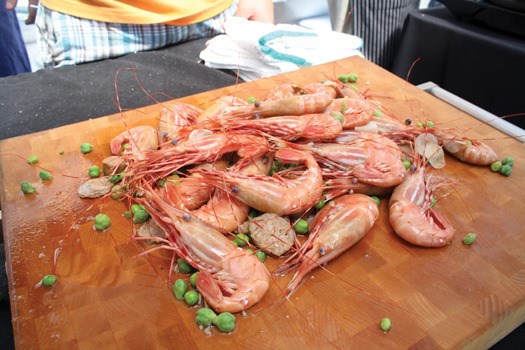Many ingredients herald the arrival of spring, but Id gladly trade all the fresh local halibut and asparagus for a bucket of spot prawns harvested in B.C. waters.
The juicy sweet crustaceans, their exoskeletons regally resplendent in red-orange and ringed white ensigns (the eponymous spots), will soon be arriving in our better restaurants and markets, served naked under a light hail of salt or finished with everything from chili-spiked coconut milk to lashings of housemade cocktail sauce.
If youve never had one before, the inner protein bewitchingly pearl-like in translucence is firmly textured at first but quickly relents with a burst of flavour comparable to the juiciest of lobsters.
I enjoy eating few things more, so it doesnt hurt that theyre also low in saturated fat and calories. When the two month window of availability shuts, I will have eaten hundreds. Perhaps you will, too.
The season begins on Saturday, May 7, a day that will see legions of foodies gathered for the 5th Annual Spot Prawn Festival at False Creeks Fishermans Wharf (just west of Granville Island on the south side of False Creek).
The event, founded by the Chefs Table Society of BC, will include a huge spot prawn boil, a series of cooking demonstrations, wine tastings, live music and educational kids activities organized by 麻豆传媒映画Aquarium staffers.
Vancouverites will also get to see many of the citys top chefs working together to support their direct seafood suppliers and, in particular, the local sale of a delicacy that used to be sent straight to markets in Asia.
Among them: Rob Clark (C Restaurant), John Bishop and Andrea Carlson (Bishops), Quang Dang (Diva at the Met), James Walt (Araxi), Hidekazu Tojo (Tojos), Wayne Martin (Crave), David Gunawan (West), Alessandra Quaglia (Provence) and Tomoki Yamasaki (Hapa Umi). And thats just a sampling of the long list of chefs who will be on hand as the day has evolved into something of a cooks jamboree.
Tickets for the prawn boil are available at the wharf for $10. Thatll get you off-the-boat spot prawns prepared by our top toques, side dishes and Terra Breads for mopping, samples of local wine and a hot cup of Mogiana coffee.
For the third year in a row, I will represent all incompetent landlubbers of the lowest order by venturing out on the water (and doing my best to stay out of the way) with fisherman Steve Johansen and his small crew to meet the very first catch of the season.
The prawning goes from dawn until noon with the pulling up of traps and the endless sorting of the sustainable critters from nearby (secret) deeps.
It is a green op totally bereft of by-catch.
From floppy ling cod to bemused octopus, all non-targets and juvenile prawns are hand-tossed back, alive and kicking, within seconds of their landing.
By the time we dock, we will have already had our fill (a happy consequence of quality testing on board), but gliding over the water toward a crowd of accomplished chefs has its regenerative benefits the thought of Bishop and Tojo waiting for us to deliver the locally caught catch of the day with which theyll cook can really inspire the appetite.
The Festival only kicks into high gear when we return which is when the hold beneath our gumbooted feet is stacked high with tray upon tray of live prawns, which Johansen will then begin to sell off his boat, the sturdy Organic Ocean, to waiting hundreds for $12 a pound.
Its become something of a tradition for me to climb to top deck of the boat with an airhorn to loudly announce our arrival. When the folks whove been watching the cooking demonstrations hear the obnoxious phwaaah! phwaaah!, they quickly form a queue.
Its an amazing day, but whats more astounding is that not even five years ago few of us had even heard of the spot prawn.
Like most other Canadians in the 1990s, we were just as besotted by the arrival and subsequent explosion of the Tiger Prawn as our dining counterparts in the United States and Europe. Huge, cheap, easy to cook and whispering of gastronomic exoticism, the Tiger Prawn was too attractive to ignore.
But what we didnt know about the $60 billion dollar a year global industry was the impact it was having on the environment and the already impoverished communities across the coastal nations of Southeast and Central Asia.
And dont forget the carbon footprint of a foodstuff being shipped thousands of kilometres to our shores.
All that aside, the truth is that they just arent very good when sampled side by side with those harvested sustainably in our own waters.
The Tiger Prawns farmed from afar may be ubiquitous and available year round, but they are a sad sight: disconcertingly flaccid and largely devoid of flavour.
Its bizarre to me that we would ever ship our outstanding prawns to Asia and volunteer for their worst, but the world works in mysterious ways.
I hope to see you down on the wharf for Spot Prawn Festival, as change is seldom this delicious.
This years event starts at 11am and runs until 3pm, with cooking demonstrations running every hour until 2pm. For more information, visit ChefsTableSociety.com



